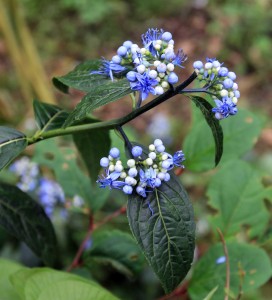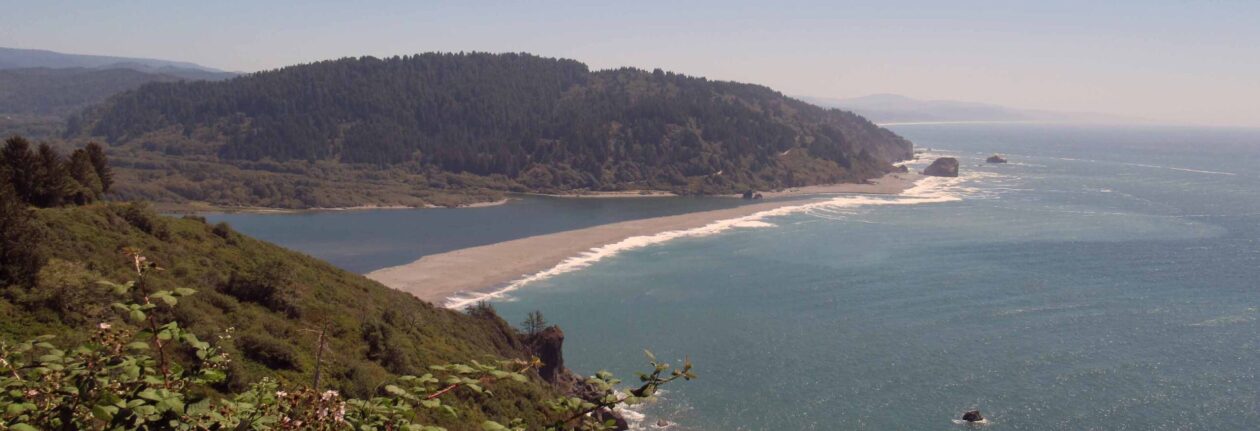Guilin, China
The attendant for our train car woke me up at 05:30 to let me know we were soon approaching Guilin. Shortly after 06:00, the train arrived and I disembarked. I bought my onward ticket to Guangzhou (the last available stop before Hong Kong – I’ll have to figure out how to get there by bus/subway/taxi from Guangzhou) and then headed north to my hostel. It was a short walk and an easy find and I was glad to see it was near the river bank in the city; however, the location was not nearly as pleasant as the one in Hangzhou – there were too many trashy looking buildings and not enough trees. Once inside the hostel, I stored my luggage, had a European breakfast (omelet, fruit, bread, butter, and jam) with an Americano and orange juice. I then gathered directions on how to get to the Longji rice terraces near Da Zhai and was soon on my way.
I walked back to the train station and took the bus that was departing from there. It was a two hour drive to the Longji (or Longsheng) Terraces Scenic Area containing the rice terraces. Once there, the bus stopped and we bought our entrance tickets. From the gate, we remained on the bus and it was another hour drive to Da Zhai. Upon entering the Scenic Area, the road became narrower with potholes filled with muddy water and parts of the road cordoned off by rock falls (to bypass one rock fall, the bus came perilously close to the ledge with not even a guardrail to offer protection). Around each sharp bend, the bus driver would honk his horn several times to alert oncoming vehicles to keep them from crashing in to us. The scenery along the route was amazing with many rocky mountains jutting out of the earth covered in thick vegetation of various shades of green and a whitewater stream below; the occasional slim waterfall could be spotted streaming down the steep slopes and the very peaks of the mountains were enveloped in misty clouds; a recent rain made everything glisten.

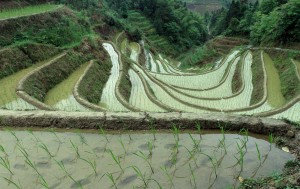
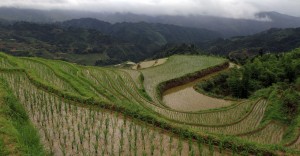
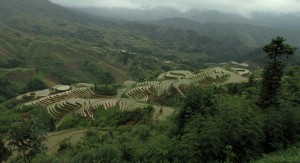
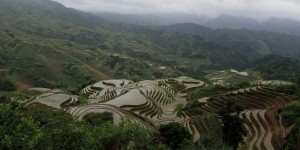
We finally reached our end destination where many old ladies dressed in the traditional clothing of their culture were there to greet us in to buying their goods; I said “no” and waved them off since I was not buying any souvenirs during my world tour. Though there was a cable car to the main lookout point which I was heading to, I decided it would be best to walk it (it proved to be the correct choice). Along the way were a number of buildings (hotels, restaurants, shops, residences) and many more were being constructed; I got the impression that the residents were making this place into a prime holiday spot – it certainly has the ideal views one would want on a vacation. I soon reached the stone steps dug in to the mountain and began the steep ascent up. A number of the stones on the path were slick with a morning rain, but all in all not too bad – I nearly slipped thrice on the descent later. Most of the trail was adjacent to the rice paddies where the local farmers could be seen tilling the soil of the drained paddies, hauling materials and vegetables in baskets, and working to maintain the terraces filled with water and neatly planted rice. Throughout the hike up I immensely enjoyed the outstanding mountain views, trees, flowers, and fresh air. It was beautiful.
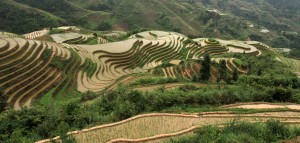
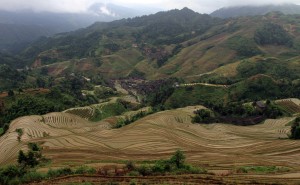
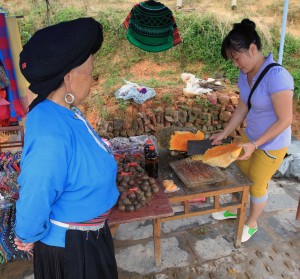
Soon I reached the high vantage point, meeting up with the small crowds of people who opted to use the cable car. Together we took in all the awe inspiring views of the numerous rice terraces (it was like looking at a three-dimensional representation of a topographic map), the green mountains, and scattered villages. This made the three hour drive here totally worth it (I am glad that the weather was on my side, I realize the scenery could easily have been shrouded in clouds). After taking a large quantity of photos, I began my descent on the other side of the mountain. Along the way, there was a lady chopping a beehive into small bits of honeycomb; she let me have a bite and it was sweet and crispy like a candy – all the liquid honey had been drained. Right next to the honeycomb butcher block were two bottles of mead with dead bees inside them – perhaps to flavor the drink or maybe to assist in fermentation? I then continued down hill through the terraces and villages, many of which had roosters, ducks, and dogs roaming about freely.
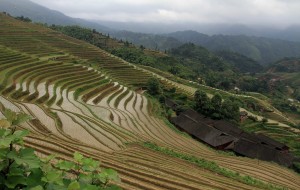
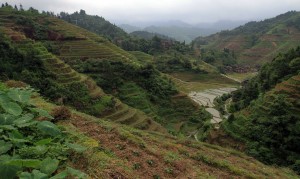

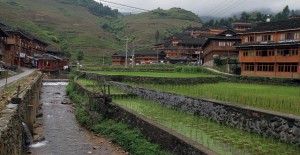
After about two hours of walking up, wandering around, and then walking back down, I was back at the bus stop. Based on directions I had been given back at the hostel and the assistance I gathered from the few English speakers (about one in three hundred Chinese will speak enough English to be able to assist someone like me; luckily there are a lot of Chinese people) I was soon on the correct bus destined to He Ping (along the way I saw the native women with their extremely long hair walking in to a restaurant – throughout the drive in the Scenic Area, there are a number of billboards and posters advertising these women who evidently wash their hair in the stream and comb it out for all to see). From there we got on to another bus to Guilin. From that stop, and with the help of two young ladies, I was soon on the correct bus that would take me near the hostel I was staying at.
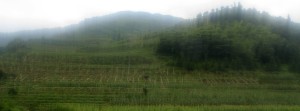

Once back at the hostel, I checked in to my room, drank a beer, and was soon off to look at Elephant Rock (a natural rock formation that looks like a gigantic stone elephant drinking from the Li River). Well, much to my disappointment, the main vantage point for viewing this prehistoric beast was blocked off forcing all curious people to pay to see it, even though it existed well before this city or human beings (one could take a boat on the river to gaze upon it, but that too would cost money). Not interested in paying to see a rock that looks like an elephant (I’ve seen at least two in my life already), I walked north along the river bank to see if I could cheat the system; unfortunately, with the view I finally got, I could not see the natural arch separating body from trunk. So I moved on to the nearby Fir Lake, where I was able to view the Moon and Sun Pagodas – for free. It was evening now and the lights on the pagodas had been turned on creating colorful reflections on the lake’s surface. But then the sky began to rain and my stomach began to rumble, so I hurried to the nearest restaurant I could find.
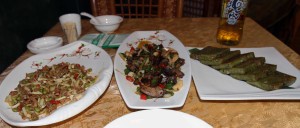
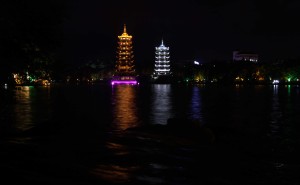
Once inside the restaurant I ordered a beer and several dishes (goose liver with onions, peppers, and garlic; sliced oysters (I think) with peppers, onion stalks, and edamame; and some green gooey loaf cut into six slices (it tasted kind of like seaweed, but the waitress told me it was taro)); also, my meal came with a tea with the solid leaves floating inside the glass. It was a delicious meal, though I didn’t really care for the green loaf (the goose liver was the best of the three cuisines). I then paid my bill and continued my trek around Fir Lake. The lake was lit up at night, similar to how West Lake was in Hangzhou, but this lake was less enchanting since only a few trees separated me from the traffic and buildings in the city; also, it was a much smaller lake, so the walk was over with all too quickly. After I finished my stroll, I went back to the hostel, caught up on yesterday’s and today’s journal, and eventually went to sleep.

